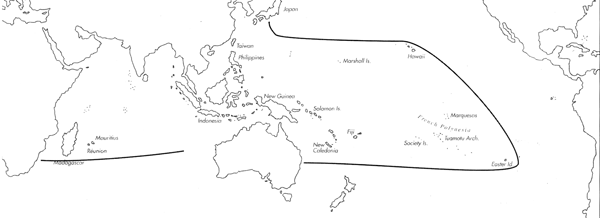
Skip Navigation Links
View access keys for this site.

Range: Entire Indo-Pacific.
Description: Small to moderately small, moderately light to moderately solid. Last whorl conical to broadly and ventricosely conical, rarely slightly pyriform; outline convex at adapical half and usually straight below. In large specimens, aperture often with a distinct spiral ridge at centre. Shoulder rounded to angulate, weakly to distinctly tuberculate. Spire of low to moderate height, outline concave to convex. Larval shell of 4-5 whorls (Taylor, 1975), maximum diameter about 0.7 mm. Postnuclear spire whorls finely tuberculate. Teleoconch sutural ramps flat to slightly concave, with 1-4 spiral grooves, obsolete on late ramps. Last whorl with fine, granulose spiral ribs on basal half.
| Shell Morphometry | ||
|---|---|---|
| L | 15-34 mm | |
| RW | 0.08-0.26 g/mm | |
| (L 15-30 mm) | ||
| RD | 0.63-0.84 | |
| PMD | 0.78-0.89 | |
| RSH | 0.06-0.18 | |
Ground colour white; in form nanus (Pl. 8, Figs. 7, 8) usually with a distinct blue shade. Usual pattern of last whorl consists of reddish brown axial flames arranged in 2 spiral rows. Flames often reduced in size or fuslng into bands. Base and basal part of columella purplish blue. Teleoconch sutural ramps with reddish to blackish brown blotches between tubercles. Aperture dark bluish violet deep within.
Periostracum yellow to brown, thin, translucent, smooth; sometimes thicker and opaque at the growing edge or in large specimens (Kohn, 1959a).
In form nanus pattern of last whorl either reduced to a few flecks and a small number of dotted and/or dashed spiral lines or completely absent; spire pattern either reduced to spots or dots between tubercles or completely absent; aperture with a light violet tone but with more pronounced brown and blue tones. Foot narrow; dorsum pale pink or white, maculated with elongate bright white markings; anterior part often with dense red streaks, or solid pink distally with 2 red lateral spots, occasionally with a dark grey central blotch; posterior part occasionally red. Sole of foot red, longtudinally streaked or variably mottled with white, usually uniformly shaded with pink, ends red; some specimens with a rather uniformly pink sole. Rostrum and tentacles variably red and white. Siphon white to red with axially white markings; tip darker pink to red; entire siphon occasionally solid pink (Kohn, 1959a & unpubl. observ.; Chaberman, pers. comm., 1981; Pearson, unpubl. observ.) (Pl. 74. Fig. 12: Pl. 78. First row, right).
Radular teeth small, with an adapical barb opposite a blade; serration extending from base of barb along the blade; shaft with 2 constrictions, just posterior to the blade and at base; basal knob with a spur (Peile, 1939; Kohn, 1963b; James, 1980).
Habitat and Habits: Abundant on intertidal benches, less common on subtidal coral reefs; some specimens dredged in 100 m (Kay, 1979). Mostly an epifaunal species, in protected and exposed sites. Intertidally on beachrock and limestone benches, usually inhabiting algal turf binding sand. small sand-filled depressions, coral rubble and crevices of rocks; less frequently on larger patches of sand or bare reef limestone. Subtidally, on reef flats, lagoon pinnacles and deeper reef habitats to ca. 18 m, inhabiting sand or reef limestone with algal turf, coral rubble and crevices of dead coral. Typical form and form nanus co-occurring in some mixed populations; however, populations often consisting predominantly or completely of one form (Kohn, 1959a, b, 1966b, 1968b; Kohn & Nybakken, 1975; Leviten & Kohn, 1980; Cernohorsky, 1964, 1978; Kay, 1979; Kilbum & Rippey, 1982; Grosch, pers. com., 1989). C. sponsalis feeds exclusively on errant polychaetes (Kohn, 1959 b; Kohn & Nybakken, 1975; Reichelt & Kohn, 1985; Kohn & Almasi, 1993). In form nanus, observed egg diameter of 135 µm predicts a minimum pelagic period of about 29 days (Perron, 1981 b; Perron & Kohn, 1985).
Discussion: C. sponsalis is closely related to C. musicus and C. parvatus. For comparison, see the Discussions of those species. Some authors (e.g. Richard, 1990) consider C. narius a distinct species. Populations occurring in southeast Polynesia and Hawaii are consistently of the narius form. However, we are unable to separate these forms morphometricalIy, and both shell colour patterns occur, with intergrades, in some geographic regions, e.g. Marshall Islands.

C. sponsalis Range Map
This section contains verbatim reproductions of the accounts of 316 species of Conus from the Indo-Pacific region, from Manual of the Living Conidae, by Röckel, Korn and Kohn (1995). They are reproduced with the kind permission of the present publisher, Conchbooks.
All plates and figures referred to in the text are also in Röckel, Korn & Kohn, 1995. Manual of the Living Conidae Vol. 1: Indo-Pacific Region.
The range maps have been modified so that each species account has it own map, rather than one map that showed the ranges of several species in the original work. This was necessary because each species account is on a separate page on the website and not confined to the order of accounts in the book.
Return to framed version (returns to search page)